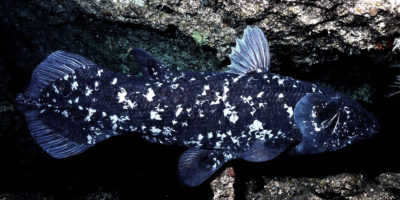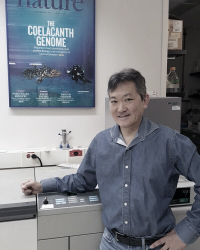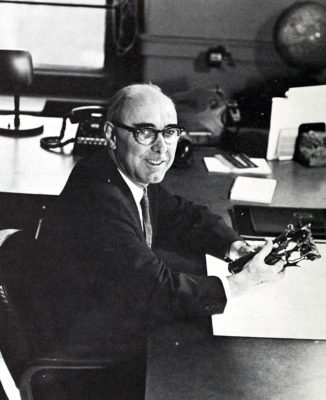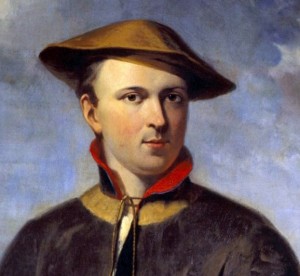 The long-awaited analysis for one of the most influential lobed-finned fish in evolution history, the coelacanth genome (pictured left), was published last week by lead scientists Chris T. Amemiya (pictured right below) of the University of Washington and Jessica Alföldi from MIT and Harvard in the prestigious journal Nature.
The long-awaited analysis for one of the most influential lobed-finned fish in evolution history, the coelacanth genome (pictured left), was published last week by lead scientists Chris T. Amemiya (pictured right below) of the University of Washington and Jessica Alföldi from MIT and Harvard in the prestigious journal Nature.
The coelacanth plays a crucial and colorful role in the history of evolution. Biologist Louis Agassiz, born in Switzerland, became a professor at Harvard University and founder of the Museum of Comparative Biology, and was the first to describe and name the fish in 1839. Ironically, Agazzi became a leading critic of Charles Darwin.
Into the twentieth century, the coelacanth fossil emerged as an example of a 70 million years old extinct fossilized link between fish and land-walking amphibians. The focus was on the coelacanth fins, specifically the hind fins with a rudimentary resemblance to feet.
In 1938, Marjorie Latimer announced the discovery of the 120 pounds “five-foot-long, a pale mauvy blue with faint flecks of whitish spots,” a live coelacanth from a marine dock off the coast of South Africa. The genus  was later named Latimeria in her honor. The discovery was considered one of the most notable zoological finds of the twentieth century – a “living fossil.”
was later named Latimeria in her honor. The discovery was considered one of the most notable zoological finds of the twentieth century – a “living fossil.”
The discovery of the live fish, thought to be an extinct transitional link, opened new avenues to explore, understand, and validate Darwin’s theory. The vertebrate land transition is one of the most important steps in evolutionary history.
Almost fifteen years elapsed before the discovery of the second specimen of this elusive species in the Comoros Islands in the Indian Ocean off the east coast of Africa. During the daytime, since coelacanths rest in caves anywhere from 100 to 500 meters deep during the day, sightings are rare.
Before the Genomic Revolution
With several clues, even before the genomic revolution, the coelacanth’s status as a transitional species was in question. For one, unlike most fish, amphibians, and reptiles, the coelacanth reproduces via live-births, not eggs.
 In 1974, paleoichthyologist Barbara Stahl concluded in Vertebrate History: Problems in Evolution –
In 1974, paleoichthyologist Barbara Stahl concluded in Vertebrate History: Problems in Evolution –
“The modern coelacanth shows no evidence of having internal organs preadapted for use in a terrestrial environment.”
Distinguished vertebrate paleontologist Edwin Harris Colbert (pictured left), curator of Vertebrate Paleontology at the American Museum of Natural History, in 1991 explains the problem –
“There is no evidence of any Paleozoic amphibians combining the characteristics that would be expected [including coelacanths].”
Coelacanth Genome
By the early twenty-first century, the genomic revolution opened molecular biologists the opportunity to investigate the molecular transitional status of the coelacanth more confidently.
The study team, led by Amemiya and Alföldi, published their paper entitled “The African coelacanth genome provides insights into tetrapod evolution” in the journal of Nature.
This Broad Institute Coelacanth Genome Project was the first to perform a phylogenetic analysis of the coelacanth genome sequence. Of the 19,033 protein-coding genes containing 21,817 transcripts studied, the team concluded –
“The protein-coding genes of L. chalumnae [coelacanth] show a decreased substitution rate compared to those of other sequenced vertebrates, even though its genome as a whole does not show evidence of low genome plasticity. The reason for this lower substitution rate is still unknown.”
Rather than finding the expected progressive changes in the genome, the evidence points to genetic stasis, not evolution by means of natural selection. As the authors explain further –
“Remarkably, their morphology is similar to that of fossils that date back at least 300 Myr, leading to the supposition that, among vertebrates, this lineage is markedly slow to evolve.”
Compounding Darwin’s dilemma, the known reproduction evolutionary problem must remain as a genomic mystery. Amemiya and Alforldi explain –
“Although Latimeria does not possess a placenta, it gives birth to live young and has very large, vascularised eggs, but the relationship between Hoxa14, the HA14E1 enhancer and blood island formation in the coelacanth remains unknown.”
The phylogenetic analysis of the coelacanth genome precludes the fish from being a transitional link from fish to land-walking amphibians. Amemiya and Alfoldi conclude –
“Through a phylogenomic analysis, we conclude that the lungfish, and not the coelacanth, is the closest living relative of tetrapods.”
Genesis
After nearly a century of research on the coelacanth as a transitional link, the genomic revolution finalizes the discussion.
As anticipated, only valid scientific theories continue to be compatible with the Genesis account, like Swedish botanist, physician, and zoologist Carolus Linnaeus (1707-1778) )pictured right) theory of species. As Linnaeus explained during the Scientific Revolution –
“All the species recognized by Botanists came forth from the Almighty Creator’s hand, and the number of these is now and always will be exactly the same.”
Refer to the Glossary for the definition of terms and to Understanding Evolution to gain insights into understanding evolution.
2020 Update
The coelacanth, once the textbook transitional link, is no longer an evolution poster child.
According to WIKIPEDIA (2020),
In the article entitled Ceolocanth, WIKIPEDIA quotes from Chris Amemiya’s 2013 paper in Nature –
“We conclude that the closest living fish to the tetrapod ancestor is the lungfish, not the coelacanth.”
Evolution 101, of the University of California, Berkely, notes –
“The coelacanth lineage exhibits about 80 million years’ worth of morphological stasis” – not evolution.
Smithsonian Institute, in the article “Coelacanth,” does not mention transitional links. The following is the only reference to evolution –
“From an evolutionary standpoint, coelacanths are more closely related to reptiles and mammals than to the common ray-finned fishes.”

